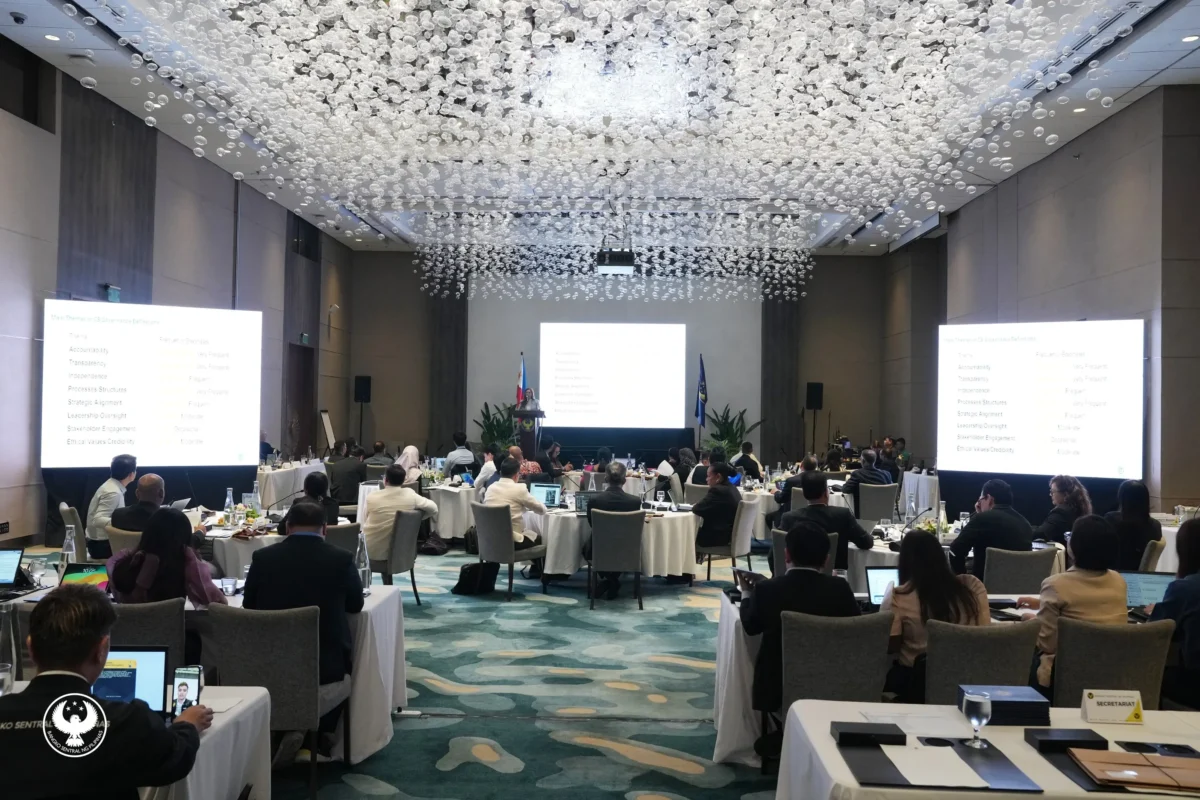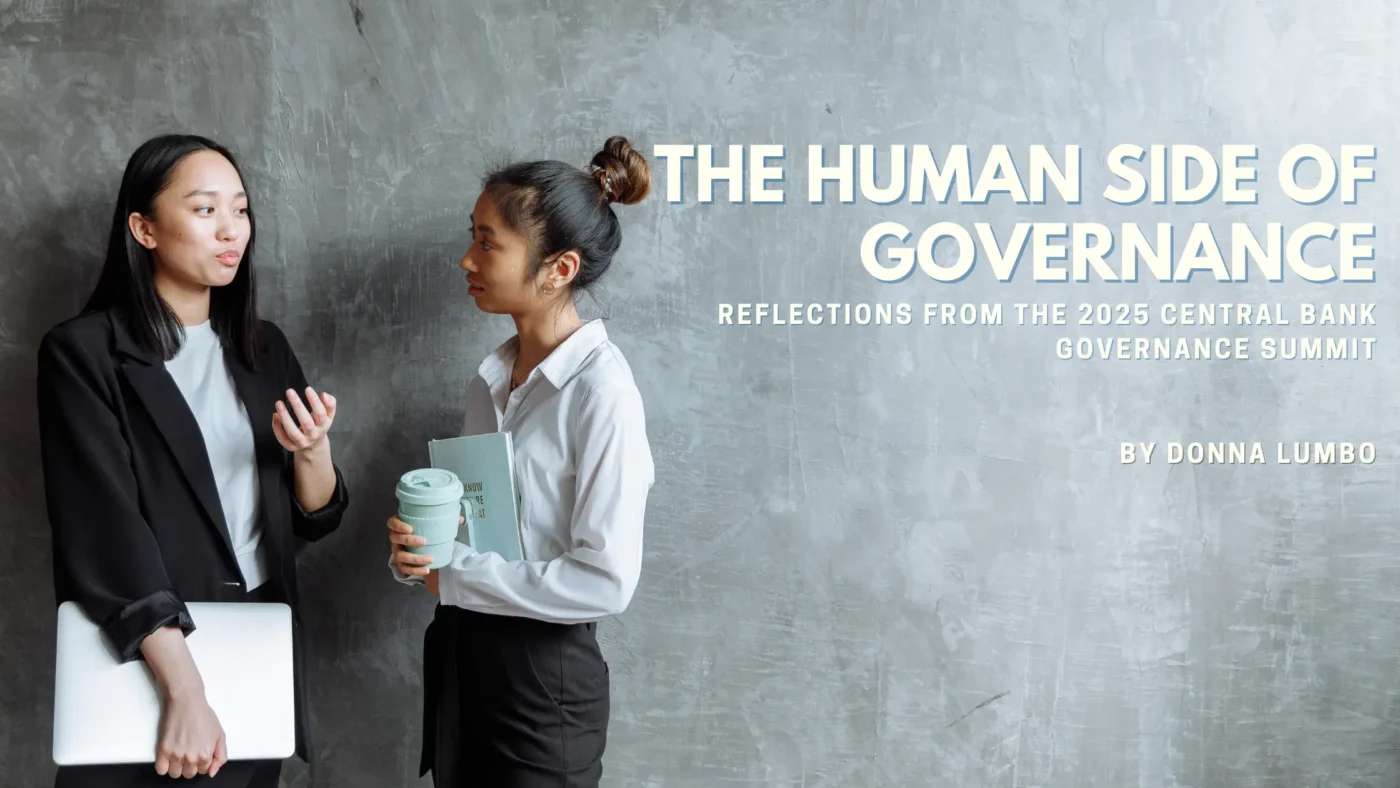How can central banks strengthen governance not only through systems and policies but through the people who make them work?
This question was tackled by senior leaders of Human Capital, Legal, Risk and Strategic Planning functions at the 2025 Governance Summit, aptly themed: “Harmonizing the People Agenda with Central Bank Governance”. This Summit, organized by the SEACEN Centre in collaboration with the Bangko Sentral ng Pilipinas (BSP), provided an avenue for these central bank leaders to discuss governance challenges and leading practices in the human capital front, including culture shifts and the evolving role of human capital in promoting a resilient and future-ready central bank.

This reflection highlights key themes that arose from the HC governance pre-summit survey, and the lessons learned that have remained front and center during the summit.
What Central Bank Governance Is
Survey respondents’ definition of central bank governance revolves around the central bank’s authority and capacity to effectively and efficiently deliver on its mandate and maintain public trust. Guided by the principles of transparency and accountability, central bank governance covers the legal mandate, structures, policies and practices that safeguard the institution. It is reflected in the way decisions are made and communicated, how structures and policies are crafted and followed, and how values are lived.
Ultimately, effective governance is not only about frameworks and systems but also about the people who bring them to life.
Human Capital: Valued, But Underutilized
Across the survey and summit discussions, one key message stood out: Human Capital (HC) is essential to good governance, though there is still room for an expanded role. HC’s most valuable contributions to good governance are tied to its efforts in leadership development and in the alignment of workforce policies to organizational strategies.
Although a few central banks had HC teams operating at a more strategic level, most recognized the need for HC to be more involved in building a resilient culture, influencing leadership and leading change transformations. Capability gaps, limited stakeholder influence, and unclear delegation of authority were identified as key barriers to taking a more strategic role. To overcome these limitations, HC needs to build its capability and secure empowerment from the top.
Technology and Governance: Work in Progress
The impact that technology has on central banking cannot be overemphasized. Its promise of efficiency comes with a set of governance risks, introducing new layers of responsibility and demanding sharper foresight and stronger digital literacy.

About 83% of the central banks acknowledged being moderately prepared for technology-driven governance challenges, with data security and privacy as the most pressing issue to all central banks. At the same time, AI, automation and workforce upskilling are top-of-mind concerns for HC leaders. When it comes to technological change and transformation, HC plays a pivotal role in ensuring the workforce is upskilled, digitally literate and confident in navigating emerging governance and people challenges.
Deputy Governor, Corporate Services Sector of the BSP, Atty. Elmore Capule, reinforced this during his keynote, outlining the BSP’s strategic focus on developing a future-ready workforce through digitally driven talent management and well-being strategies. He emphasized that digital literacy and capacity-building is central to how central banks ensure good governance in a technology-driven world.
The Balancing Act: Governance Tradeoffs
One of the most compelling themes to emerge from the Summit was the articulation of governance trade-offs: innovation and caution, transparency and confidentiality, and agility and stability.
Central banks face an increased pressure to innovate in response to digital transformation and technological revolution yet must do so within a framework designed to uphold financial and economic stability and manage risk.
Transparency reduces uncertainty and enables the public to understand and anticipate central bank decisions, reinforcing public trust and policy credibility. However, respondents also recognized that too much disclosure can sometimes make it harder for central banks to act effectively, just as too much secrecy can invite misunderstanding or misrepresentation.
Lastly, organizational agility, defined as the ability to respond quickly in a complex, fast-changing world, is often held back by rigid hierarchies and long approval processes, making it difficult for central banks to act with speed and confidence. Complex governance structures and limited delegation of authority can slow adaptation and weaken the central bank’s ability to respond promptly to emerging risks. One respondent wrote, “To effectively navigate the VUCA world, we must be agile and flexible. However, our culture and management style continue to adhere to a hierarchical structure.”
Amid these tensions, Mr. Marzunisham Omar, Deputy Governor of Bank Negara Malaysia, offered a powerful reminder that trust is the anchor holding all these forces in balance. He asserted, “Trust must be earned, deepened and handed forward”. While navigating between these tradeoffs is a continuous test of judgment, the central bank will not falter if it stays true to its north star. His message captured the essence of what it means to govern with accountability, conscience and conviction.
Culture and Resilience: Transformation from the Inside Out
When participants reflected on the factors that hinder transformation the most, answers revolved around resistance to change, bureaucracy and lack of visible leadership- all of which are manifestations of culture.
Resilient organizations thrive on open communication, clear direction and adequate support mechanisms during times of change. People expect transparency, inclusiveness and open dialogue from their leaders. Participants had conversations around how leaders show up, listen and communicate, and drive a culture that supports good governance and transformation.
In the words of Mr. Dennis Boncod, Assistant Governor of the BSP, “To govern well is to grow wisely with people at the center and integrity at every turn. Leaders living the strategy entails embodying the core values in every action and decision, espousing a collaborative mindset, and leading through change.”
Closing Reflection: People at the Heart of Governance
The most encouraging shift that emerged from the survey and summit is the growing importance and appreciation of human capital as a strategic shaper of governance. From influencing leadership practices and culture to embedding ethics in decision-making, and guiding AI governance, HC is taking a more active role in shaping the future.

Some feedback from the summit participants:
“I like the fact that HC contributes significantly to the (organization’s) governance to build public trust towards central bank.”
“The wealth of knowledge imparted by a fantastic lineup of presenters to the meaningful discussions shared exceeded all expectations. Personally, l’ve attended conferences and training in over 20 countries, this has been the best- a testament to the thoughtfulness and brilliance of this events’ organization.”
“Learning from peer central bankers and speakers provided great insight.”
“The hospitality extended by Bangko Sentral ng Pilipinas and SEACEN was first-class, raising expectations and defining what exceptional hospitality and learning synergy should be across the SEACEN network. The environment was relaxed, engaging, and memorable – proving that serious learning can happen in a fun and inspiring setting.”
Mr. Christopher Lee Choon Keat, a participant from BNM, indicated:
“The programme design struck a good balance between structured content and real-world insights from career central bankers and industry thought leaders. What stood out most was the emphasis on governance as a living practice, not just a theoretical construct. The summit encouraged open dialogue on emerging risks, innovation, and leadership agility – critical areas for central banks navigating today’s dynamic environment. This holistic approach made the experience not only educational but impactful and forward-looking, equipping us with practical insights and a renewed sense of purpose to strengthen governance in an evolving financial landscape.
SEACEN’s unique proposition lies in fostering camaraderie among fellow central bankers, complemented by the warmth of Asian hospitality. Unlike many regional or international programmes, the relationships built here are long-term and invaluable – creating informal networks that accelerate collaboration, benchmarking, and knowledge sharing well beyond the classroom.”
Moving forward, participants voiced support for regional collaboration initiatives such as shared frameworks, benchmarking activities and leadership programs that build collective capability across central banks. This spirit of collaboration reflects the ASEAN approach- one that is grounded in trust, reciprocity and mutual interdependence, as discussed in the presentation of SEACEN’s Executive Director, Dr. Cynyoung Park.
As central banks look ahead, the real opportunity lies in turning insights into action: empowering human capital, practicing inclusive leadership and cultivating cultures that are both resilient and accountable.
Donna Lumbo is a Senior Analyst in the Leadership, Governance, and Human Capital Pillar at the SEACEN Centre.

